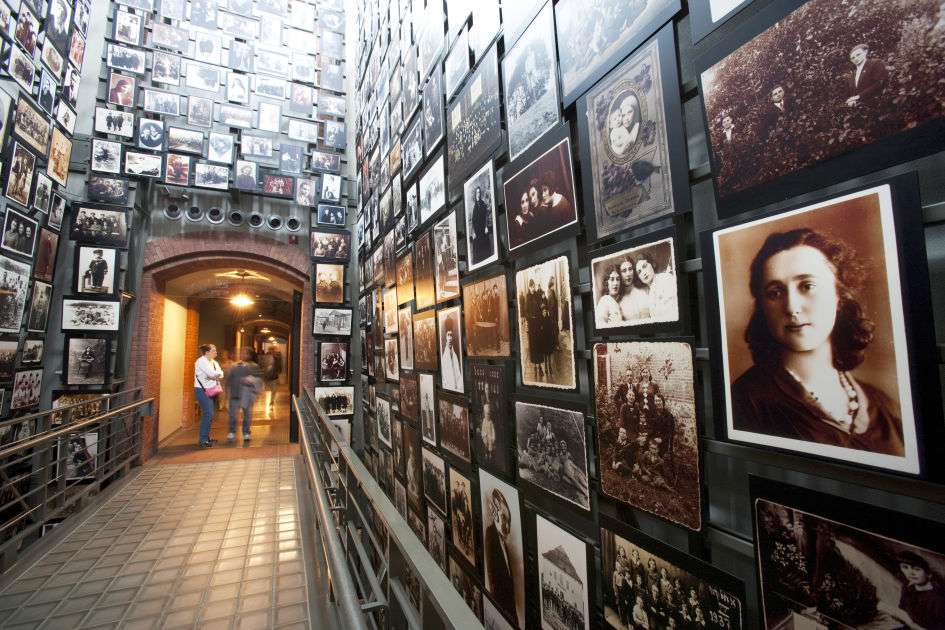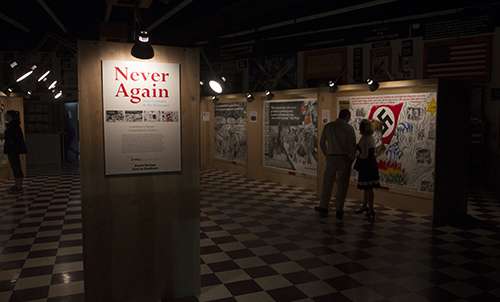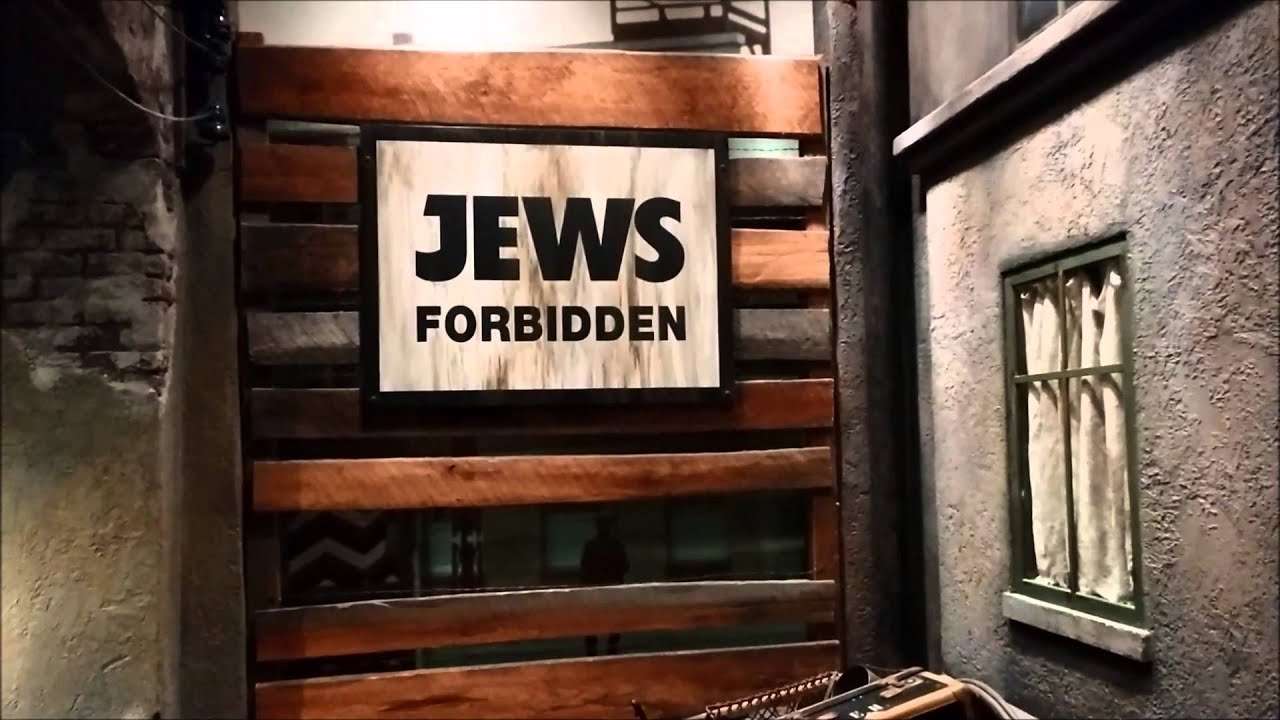Encyclopedia Of Camps And Ghettos
Encyclopedia of Camps and Ghettos, 1933â1945Arbeit Macht Frei
The Encyclopedia of Camps and Ghettos, 1933â1945 is a seven-part encyclopedia series that explores the history of the concentration camps and the ghettos in German-occupied Europe during the Nazi era. The series is produced by the USHMM and published by the Indiana University Press. The work on the series began in 2000 by the researchers at the USHMM’s Center for Advanced Holocaust Studies. Its general editor and project directory is the American historian Geoffrey P. Megargee. As of 2017, two volumes have been issued, with the third being planned for 2018.
Volume I covers the early camps that the SA and SS set up in the first year of the Nazi regime, and the camps later run by the SS Economic Administration Main Office and their numerous sub-camps. The volume contains 1,100 entries written by 150 contributors. The bulk of the volume is dedicated to cataloguing the camps, including locations, duration of operation, purpose, perpetrators and victims. Volume II is dedicated to the ghettos in German-occupied Eastern Europe and was published in 2012.
New Chapter For Collections
In 2015, the Museum broke ground on the David and Fela Shapell Family Collections, Conservation, and Research Center, a state-of-the-art home for the Museum’s collection of record on the Holocaust. The center serves as a hub of activity supporting acquisitions, education, and scholarship to ensure that future generations will continue to honor the memory of Holocaust victims and learn from their history to build a better future.
History Of The United States Holocaust Memorial Museum
The United States Holocaust Memorial Museum is Americas national institution for the documentation, study, and interpretation of Holocaust history, and serves as this countrys memorial to the millions of people murdered during the Holocaust. It opened in April 1993.
The creation of the United States Holocaust Memorial Museum began as an idea in 1978. Transformed into reality, it has become an internationally recognized institution visited by nearly 2 million people annually.
Also Check: Phillip And Patricia Frost Museum
What Were Ghettos And Why Did German Authorities Create Them During The Holocaust
Ghettos were areas of cities or towns where German occupiers forced Jews to live in overcrowded and unsanitary conditions. German authorities often enclosed these areas by buildingwalls or other barriers. Guards prevented Jews from leaving without permission. Some ghettos existed for years, but others existed only for months, weeks, or even days as holding sites prior to deportation or murder.
German officials first created ghettos in 19391940 in German-occupied Poland. The two largest were located in the occupied Polish cities of Warsaw and Lodz . Beginning in June 1941, German officials also established themin newly conquered territories in eastern Europe following the German attack on the Soviet Union. German authorities and their allies and collaborators also established ghettos in other parts of Europe. Notably, in 1944, German and Hungarian authorities created temporary ghettos to centralize and control Jews prior to their deportation from Hungary.
Us President Denounces The Nazis

At his press conference on November 15, 1938, one week after Kristallnacht, President Franklin D. Roosevelt denounced Nazi Germanys terror attack on Jews, saying, I myself could scarcely believe that such things could occur in a twentieth-century civilization. FDR made an exception to his practice of off-the-record press conferences by allowing newspapers to quote this statement from his meeting with reporters that day.
The president also announced that he had recalled the US ambassador to Germany, Hugh Wilson. The United States was the only nation to recall its ambassador and would not replace him until after the end of the war in 1945.
In response to the news of Nazi terror against Jews, Americans protested in cities including New York and Los Angeles. Other Americans called for an increase in the number of immigrants allowed to enter the country.
Also Check: University Of Arizona Museum Of Art
A Living Memorial To The Holocaust
A living memorial to the Holocaust, the United States Holocaust Memorial Museum inspires citizens and leaders worldwide to confront hatred, prevent genocide, and promote human dignity. Federal support guarantees the Museums permanent place on the National Mall, and its far-reaching educational programs and global impact are made possible by generous donors.
Located among our national monuments to freedom on the National Mall, the Museum provides a powerful lesson in the fragility of freedom, the myth of progress, and the need for vigilance in preserving democratic values. With unique power and authenticity, the Museum teaches millions of people each year about the dangers of unchecked hatred and the need to prevent genocide. And we encourage them to act, cultivating a sense of moral responsibility among our citizens so that they will respond to the monumental challenges that confront our world.
Today we face an alarming rise in Holocaust denial and antisemitismeven in the very lands where the Holocaust happenedas well as genocide and threats of genocide in other parts of the world. This is occurring just as we approach a time when Holocaust survivors and other eyewitnesses will no longer be alive.
The United States Holocaust Memorial Museum And American University
American University’s Jewish Studies Program works closely with the United States Holocaust Memorial Museum , located in downtown Washington, DC, to offer AU students opportunities to deepen their knowledge of the Holocaust. AU students intern and volunteer at the USHMM, and the Jewish Studies Program, Department of History, and the USHMM collaborate on a jointly sponsored Holocaust Studies Forum.
You May Like: Museum Of Western Art Kerrville
What Was The Final Solution To The Jewish Question
The Nazi Final Solution to the Jewish Question was the deliberate and systematic mass murder of European Jews. It was the last stage of the Holocaust and took place from 1941 to 1945. Though many Jews were killed before the “Final Solution” began, the vast majority of Jewish victims were murdered during this period.
As part of the Final Solution,Nazi Germany committed mass murder on an unprecedented scale. There were two main methods of killing. One method was mass shooting. German units carried out mass shootings on the outskirts of villages, towns, and cities throughout eastern Europe. The other method was asphyxiation with poison gas. Gassing operations were conducted at killing centers and with mobile gas vans.
United States Holocaust Memorial Museum
| Location in Washington, D.C.Show map of Central Washington, D.C.United States Holocaust Memorial Museum Show map of the United States |
| Established |
|---|
| www.ushmm.org |
The United States Holocaust Memorial Museum is the United States’ official memorial to the Holocaust. Adjacent to the National Mall in Washington, D.C., the USHMM provides for the documentation, study, and interpretation of Holocaust history. It is dedicated to helping leaders and citizens of the world confront hatred, prevent genocide, promote human dignity, and strengthen democracy.
The museum has an operating budget, as of September 2018, of $120.6 million. In 2008, the museum had a staff of about 400 employees, 125 contractors, 650 volunteers, 91 Holocaust survivors, and 175,000 members. It had local offices in New York City, Boston, Boca Raton, Chicago, Los Angeles, and Dallas.
Since its dedication on April 22, 1993, the museum has had nearly 40 million visitors, including more than 10 million school children, 99 heads of state, and more than 3,500 foreign officials from over 211 countries and territories. The museum’s visitors came from all over the world, and less than 10 percent of the museum’s visitors are Jewish. Its website had 25 million visits in 2008, from an average of 100 countries daily. Thirty-five percent of these visits were from outside the United States.
Recommended Reading: Natural History Museum Dc Hours
American Press Reports On Kristallnacht
American newspapers across the country covered the Nazi assault on Jews in front-page, banner headlines, and articles about the events continued to appear for several weeks. No other story about the persecution of the Jews received such widespread and sustained attention from the American press at any other time during the Nazi era.
German censors sought to block images of Kristallnacht from reaching newspapers in the United States. However, Life magazine was able to publish some images in its November 28, 1938, issue.
Perhaps no headline so aptly summarized the danger for the Jews under the Nazi regime than that published on the front page of the Los Angeles Examiner on November 23, 1938: Nazis Warn World Jews Will Be Wiped Out Unless Evacuated By Democracies.
Center For Advanced Holocaust Studies
In 1998, the United States Holocaust memorial Museum established the Center for Advanced Holocaust Studies . Working with the Academic Committee of the United States Holocaust Memorial Council, the CAHS supports research projects and publications about the Holocaust , helps make accessible collections of Holocaust-related archival material, supports fellowship opportunities for pre- and post- doctoral researchers, and hosts seminars, summer research workshops for academics, conferences, lectures, and symposia. The CAHS’s Visiting Scholars Program and other events have made the USHMM one of the world’s principal venues for Holocaust scholarship.
Don’t Miss: St Augustine Medieval Torture Museum
How Do I Get A Ticket
Reserve tickets online before your visit to the Museum. The Museum and its exhibitions are open from 10 a.m. to 5:30 p.m.
Advance tickets online: Tickets through May 2022 are available now.
Same-day tickets online: A limited number of same-day tickets will be available online each day at 7 a.m.
The Early Warning Project Assesses The Risk Of Mass Atrocities In Countries Around The World

Genocide and mass atrocities are devastating crimes in their scale and scope, in their enduring psychic scars for survivors, and in the long-term trauma they cause in societies where they occur. Despite past efforts to address systematic killing, and a body of law formed after the Holocaust to prevent and punish perpetrators, such crimes persist.
We use quantitative and qualitative methods to spotlight countries where mass atrocities have not begun, but where the risk for such violence is high.
We strive to improve this early warning system for mass atrocities by using a variety of publicly available data and forecasting methods.
The Early Warning Project, a first-of-its-kind public system, is a joint initiative of the Simon-Skjodt Center for the Prevention of Genocide at the United States Holocaust Memorial Museum and the Dickey Center for International Understanding at Dartmouth College.
Also Check: Whaling Museum New Bedford Ma
United States Holocaust Memorial Museum Washington Dc: Hours Address United States Holocaust Memorial Museum Reviews: 45/5
Message From The Director
“Whenever this history is questioned, whenever violence is done to the memory of the victims, the rise of anti-Semitism and hate speech is encouraged, an everyday scourge of Jewish communities around the world. More than ever, we must therefore be vigilant. It is our shared responsibility to protect the truth, and to keep alive the memory of all those who suffered under the Nazi regime to support research and documentation that can confront the fantasies of fanatics with the reality of history and to study and teach the Holocaust, so that education may prevent anti-Semitism and all forms of racism.” Audrey Azoulay, Director-General of UNESCO, on the occasion of International Day of Commemoration in Memory of the Victims of the Holocaust
You May Like: Academy Of Motion Picture Arts And Sciences Museum
Holocaust Museum Architecture And Contents
Riches, Rivals & Radicals: 100 Years of Museums in AmericaSee all videos for this article
Architects of many of these modern museums sought to imbue their new spaces with symbolism and significance. At the United States Holocaust Memorial Museum, American architect James Ingo Freed created a space intended to render the visitor slightly off-balance and on edge. The Holocaust Memorial Centre in Budapest, with a new wing designed by István Mányi, resides in an asymmetrical building with dislocated walls, which are intended to symbolize the distorted and twisted era of the Holocaust. Architect Stanley Tigermans design for the Illinois Holocaust Museum and Education Center divided the building into dark and light sections. Visitors descend into the darkness to view exhibits revealing the horrors of the time period. They then view a Book of Remembrance with the names of the victims at the centre of the museum before exiting through a portion of the building filled with natural sunlight that symbolizes the time of rescue and renewal.
Who Were The Other Victims Of Nazi Persecution And Mass Murder
The Holocaust specifically refers to the systematic, state-sponsored persecution and murder of six million Jews. However, there were alsomillions of other victims of Nazi persecution and murder. In the 1930s, the regime targeted a variety of alleged domestic enemies within German society. As the Nazis extended their reach during World War II, millions of other Europeans were also subjected to Nazi brutality.
The Nazis classified Jews as the priority enemy. However, they also targeted other groups as threats to the health, unity, and security of the German people. The first group targeted by the Nazi regime consisted of political opponents. These included officials and members of other political parties and trade union activists. Political opponents also included people simply suspected of opposing or criticizing the Nazi regime. Political enemies were the first to be incarcerated in Nazi concentration camps. Jehovahs Witnesses were also incarcerated in prisons and concentration camps. They were arrested because they refused to swear loyalty to the government or serve in the German military.
The Nazi regime also targeted Germans whose activities were deemed harmful to German society. These includedmen accused of homosexuality, persons accused of being professional or habitual criminals, and so-called asocials . Tens of thousands of these victims were incarcerated in prisons and concentration camps. The regime also forcibly sterilized and persecuted Afro-Germans.
Don’t Miss: Hotels Near Walton’s Mountain Museum
The Purpose Of The Ghettos
German authorities originally established the ghettos to isolate and control the large local Jewish populations in occupied eastern Europe. Initially, they concentrated Jewish residents from within a city and the surrounding area or region. However, beginning in 1941, German officials also deported Jews from other parts of Europe to some of these ghettos.
Jewish forced labor became a central feature of life in many ghettos. In theory, it was supposed to help pay for the administration of the ghetto as well as support the German war effort. Sometimes, factories and workshops were established nearby in order to exploit the imprisoned Jews for forced labor. The labor was often manual and grueling.
Survival Outside Of German
Some Jews survived the Holocaust by escaping German-controlled Europe. Before World War II began, hundreds of thousands of Jews emigrated from Nazi Germany despite significant immigration barriers. Those who immigrated to the United States, Great Britain, and other areas that remained beyond German control were safe from Nazi violence. Even after World War II began, some Jews managed to escape German-controlled Europe.For example, approximately 200,000 Polish Jews fled the German occupation of Poland. These Jews survived the war under harsh conditions after Soviet authorities deported them further east into the interior of the Soviet Union.
Read Also: Art Museum Real Estate Philadelphia
United States Holocaust Memorial Museum Washington Dc
Confirm Time SlotDESCRIPTION
Welcome to the United States Holocaust Memorial Museum. Here is some helpful information for your visit. Please arrive at least 15 minutes prior to allow for security and health screening. Museum entry is only available at the entrance located on 14th Street. The Museum is reopening with reduced visitation, required face coverings, social distancing, and other enhanced safety measures. Timed entry tickets will be required for entry into the building.
WHAT IS REQUIRED TO ENTER THE MUSEUM?Masks Maintain social distance.Wash or sanitize hands often.
Arrests Of Jewish Men

As the pogrom spread, units of the SS and Gestapo , following Heydrich’s instructions, arrested up to 30,000 Jewish males, and transferred most of them from local prisons to Dachau, Buchenwald, Sachsenhausen, and other concentration camps.
Significantly, Kristallnacht marks the first instance in which the Nazi regime incarcerated Jews on a massive scale simply on the basis of their ethnicity. Hundreds died in the camps as a result of the brutal treatment they endured. Most did obtain release over the next three months on the condition that they begin the process of emigration from Germany. Indeed, the effects of Kristallnacht would serve as a spur to the emigration of Jews from Germany in the months to come.
Recommended Reading: World War Ii Museum Kansas City
National Institute For Holocaust Education
The USHMM conducted several programs devoted to improving Holocaust education. The Arthur and Rochelle Belfer Conference for Teachers, conducted in Washington, D.C., attracted around 200 middle school and secondary teachers from around the United States each year. The Education Division offered workshops around the United States for teachers to learn about the Holocaust, to participate in the Museum Teacher Fellowship Program , and to join a national corps of educators who served as leaders in Holocaust education in their schools, communities, and professional organizations. Some MTFP participants also participated in the Regional Education Corps, an initiative to implement Holocaust education on a national level.
Since 1999, the USHMM also provided public service professionals, including law enforcement officers, military personnel, civil servants, and federal judges with ethics lessons based in Holocaust history. In partnership with the Anti-Defamation League, more than 21,000 law enforcement officers from worldwide and local law enforcement agencies such as the FBI and local police departments have been trained to act in a professional and democratic manner.